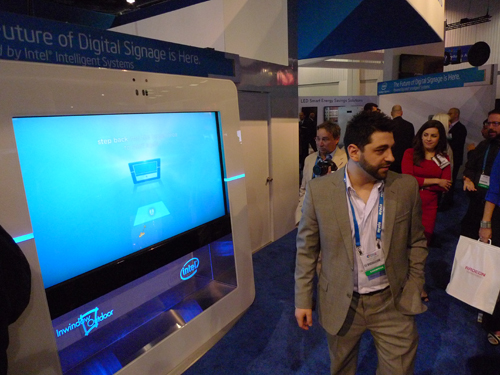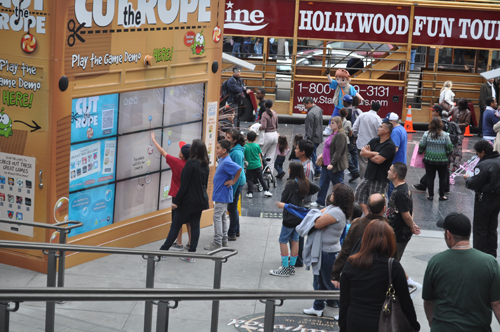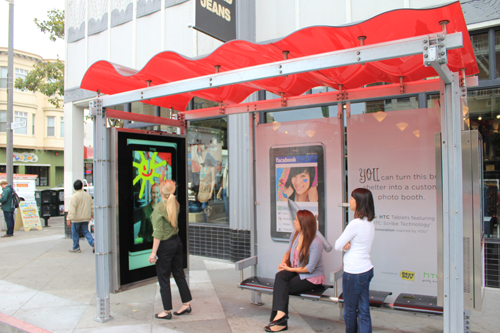Beyond Call to Action– Getting the Viewer Involved in Real Time
By Alan Brawn
- Some may argue that interactivity is simply the latest trend or technology dejour but the argument is hollow especially if we look at the past and the evolution of interactivity and where it has taken us today. From a definition perspective, interactive means:
• Acting one upon or with another.
• Of or pertaining to a two-way system of electronic communications, as by means of television or computer:
• Of a computer program or system interacting with a human user, often in a conversational way, to obtain data or commands and to give immediate results or updated information.

Anthony DiPrizio of Inwindow Outdoor demos the Experience Station at Digital Signage Expo in March. Intel and Inwindow Outdoor have developed the “Experience Stations”, capable of interacting in a multitude of ways. On the hardware side, these units incorporate large-format 70” touchscreen displays to accept multi-touch inputs; near field communication (NFC) for two-way transactions with mobile devices; and 3d cameras so customers can precisely control the sign with gestures. When people approach, real-time analytics software determines their gender and age and subsequently plays targeted advertising based on the audience demographics; therefore, showing the right message to the right people at the right time.
Definitions aside, the concept of interactivity dates back to prehistoric times and relates to the day when digital meant using a finger or digit. Okay so it was a bad joke but it goes a long way back to say the least and has a lot of historical context from which we draw the near universal acceptance we see today. The concept gained momentum in our school systems with the use of blackboards and white boards with teachers and students standing at the boards and sharing information, formulas, drawings, etc. to make points more clear than language alone. It was helped along the way with the introduction of the PC and MAC with the ability to use a mouse and click on icons to take us where we wanted to go. The cool thing was that we clicked and got a response in return or at least so we hoped if the computer did not crash. As ubiquitous as this has become, the good old mouse actually stood in the way of what might be called natural interactivity where the mechanical interface to a device is not needed to make an action happen and get a response.
The concept of natural interactivity is most famously seen in the movies 2001 A Space Odyssey (thanks HAL) and Minority Report as well as the TV show Start Trek where you could stand in front of a screen and talk to it or wave your arms and the response on screen or via audio was instantaneous. Just like Dick Tracey and his wrist radio, we are now there and this is all being assimilated into our everyday lives not to mention digital signage realm all around us.
While not 100% historically accurate the modern uses of interactivity began or should we say flourished with the airlines and their ticketing procedures at those infamous kiosks that so often did not work. Remember the staff standing nearby when it all failed? The real boom in interactivity relates to work done by Jeff Han of NYU with his touch and multi-touch demonstrations in the early part of this century. It sounds old but in fact it is less than a decade since his work emerged onto the technological scene. The most famous applications of what he developed have been in the smart phones that seemingly everyone has in their pockets or purses. We have actually been programmed to touch the screen on the phone to access applications, get contacts, text messages, send e-mails, and yes even answer the phone or make an outgoing call. The gaming industry has not been left out of the picture and the Wii with its interactive capabilities of standing away from the screen and playing games and even exercising, has brought a new dimension to the concept of interactivity.
INTERACTIVITY AND DIGITAL SIGNAGE
Since we now have incorporated interactivity into our daily lives from a consumer point of view, we have come to expect and even demand interactivity in digital signage. As digital signage expands and screens are literally popping up all around us people expect to be able to touch them and have something happen. Now this can be a simple touch and response as in way finding or it can be full two way communication as in a computer interaction or even a complete communication package as in video conferencing with a video concierge or customer service conversation back and forth. In fact, a recent experience of a friend of mine emphasizes how interactivity has come to be so pervasive. She went to a big name hotel recently and in the lobby was a large digital sign with information about the hotel on the screen. Right below the monitor was a static sign that read “Sorry, this is not a touch screen.” Okay, enough said. This is not a trend but a fact of everyday life so what is the next step in this evolution in connectivity?

For the EA Cut The Rope (Electronic Arts), Monster Media created a unique event based on interactive digital signage. At two locations: Hollywood & Highland Center, Los Angeles, and Hartsfield-Jackson Atlanta International Airport. Through multi-touch interaction, consumers could team up to play a larger-than-life demo version of the game. Simultaneously, other consumers could explore additional EA mobile games by viewing promo trailers and reading game descriptions on another portion of the screen! Using their iPhone, iPod Touch or iPad, consumers could also scan QR codes to download Cut the Rope or other featured mobile games.
Truth be told, there is a lot going on in the world of interactivity especially in digital signage. I won’t bore you with the technological advances in the different types of touch technologies but please note that there is a vast difference in what we knew as touch screen a few years ago and what we see today. The biggest advances are in the sensitivity of the touch experience and of course in multi touch. From the sensitivity point of view we are seeing a more accurate response from the finger touch on screen as contrasted to a much cruder or coarse rendition a few years back. Today you can even use touch as an art form on screen. From a multi touch perspective dating back to Jeff Han again, we see applications that support up to 50 points of touch at the same time!
Let’s take a brief look at what is going on today. Our first example is the new SUR40 “Table” from the people at Samsung and Microsoft. This is a table that permits up to 50 touch points onscreen at any one time and via a patented camera in pixel technology it can even tell what an object is that is placed on the screen surface. It senses that a glass is placed on the table or any 3D object and responds accordingly. We have full video walls that can be turned into touch screens with multi touch capabilities. At the recent DSE in Las Vegas the Salitek and Orion team showed a 117” touch screen wall with multi touch. Christie Digital and their MicroTiles have nearly unlimited touch capabilities in non-traditional aspect ratios and of course the big LCD manufacturers like Samsung, NEC, LG, and now Planar and Viewsonic have their thin bezel LED illuminated screens that can be used stand alone or in video walls. It seems that we can turn anything into an interactive device but it does not stop there.
From a digital signage perspective interactivity is becoming the norm and no longer some frivolous option that might have been a curiosity in the early days but now imagine how mobile interactivity will affect these applications and take them to the next level of acceptance. The smart phone can be used in an NFC or near field communication manner and just by interacting with the big screen the information is transferred to the smart phone or tablet where personal interactivity takes place. We have companies like Samsung who are making new Galaxy Note that transcends both cell phone and tablets with both finger touch and stylus capabilities. Linking mobile devices to digital signage of all types is the next progressive step. Last but not least in terms of flat panel displays we are seeing interactive kiosks with both medium and large displays that give us full interactivity with video conferencing thrown in for good measure. This is being driven by lower bandwidth requirements for these applications and improvements in touch sensitivity.

Monster Media’s cutting-edge touch interactive displays acted as oversized demo versions of the tablet and simulated the features of the HTC Scribe™ technology (two locations: NCM Theaters Nationwide; and 10 San Francisco Bus Shelters). The displays captured the attention of consumers by encouraging them to snap a photo and personalize it using different brush styles, strokes and colors. After completing their masterpiece, a full keyboard appeared for artists to enter their email address to send their custom work of art!
Lest you think that we are ignoring projection which makes up 30% of the digital signage market, fear not. With the advent of shortthrow projectors we are able to mount a projector in the ceiling with a short throw offset optic and project large images on a screen or wall without the viewer getting in the way of the light path. Combined with technologies like interactive DLP using a wireless pen to move a cursor around the screen, and adding interactive software to the equation you have a cost effective way to get the large images you desire, the interactivity that makes it effective, and at a price that will not break the budgetary bank.
We constantly teach or some would say preach that when technology, application and price converge an opportunity is created. Nowhere is this truer than in digital signage withinteractivity. Over 70% of the US population is confronted with digital signage each and every day and 64% of our devices are hooked together in some manner. While digital signage has become the communication medium for all sorts of industries’ from retail to corporate to education and healthcare, it is inclusion of what we like to call natural interactivity that clears the way for growth in the industry and the development of new applications to take advantage of what we have at our fingertips.
